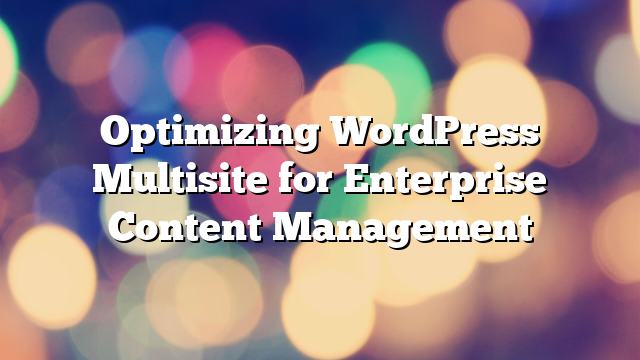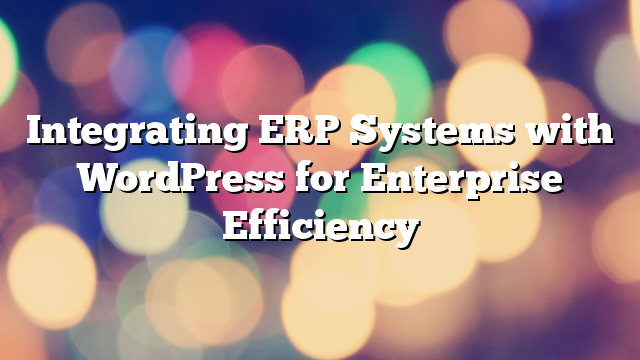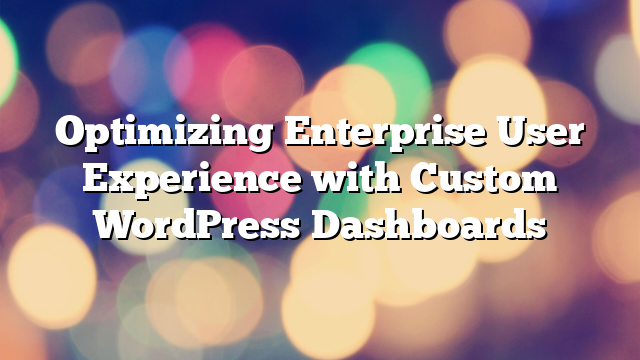Optimizing WordPress Multisite for Enterprise Content Management
17.10.2024

Managing multiple websites within a large organization can be a daunting task. For enterprises that need to oversee numerous websites while maintaining consistency and control, WordPress Multisite is an ideal solution. WordPress Multisite allows businesses to create a network of sites from a single WordPress installation, offering centralized management, streamlined updates, and scalable solutions. In this article, we’ll explore how enterprises can optimize WordPress Multisite for effective content management and meet the challenges of running a network of sites.
What is WordPress Multisite?
WordPress Multisite is a feature that enables businesses to create a network of sites within one WordPress installation. This feature is particularly useful for enterprises that manage different websites under the same corporate umbrella, such as regional websites, product-specific sites, or franchise locations. Instead of setting up and maintaining multiple independent WordPress installations, enterprises can manage all sites from one dashboard.
Benefits of WordPress Multisite for Enterprises
For large-scale organizations, WordPress Multisite offers several advantages that make it an excellent choice for enterprise content management:
1. Centralized Management
With WordPress Multisite, administrators can manage multiple websites from a single dashboard, streamlining tasks such as updating plugins, managing users, and monitoring performance. This centralized approach simplifies the management process, reducing the time and effort needed to maintain individual sites.
For example, an enterprise with dozens of regional websites can push theme and plugin updates across all sites with a few clicks, ensuring consistency and saving time. This centralized control is essential for enterprises that need to enforce brand guidelines and maintain uniformity across multiple sites.
2. Cost-Effective and Scalable
Running a single WordPress Multisite installation is more cost-effective than maintaining separate WordPress instances for each site. Enterprises can save on hosting, maintenance, and infrastructure costs by consolidating resources. Additionally, Multisite offers scalability, allowing businesses to add new sites to the network without setting up new installations from scratch.
As businesses grow and require additional websites, WordPress Multisite can easily accommodate new sites within the existing infrastructure. This scalability makes it an ideal solution for expanding enterprises that need to launch new websites quickly and efficiently.
3. Role-Based Access and User Management
Enterprises often have multiple teams and stakeholders involved in content creation and site management. WordPress Multisite allows administrators to assign specific roles and permissions to users across the network or for individual sites. This role-based access ensures that the right people have the appropriate permissions, enhancing security and reducing the risk of unauthorized changes.
For example, corporate administrators can maintain full control over all sites, while local teams can be granted access to manage content on their specific sites. This granular control allows enterprises to distribute responsibilities while maintaining overall governance of the network.
4. Streamlined Updates and Maintenance
One of the biggest challenges for enterprises managing multiple websites is keeping them up-to-date with the latest security patches, plugin updates, and themes. WordPress Multisite simplifies this process by enabling updates to be applied network-wide from a single location.
With WordPress Multisite, enterprises can ensure that all sites are using the most up-to-date versions of plugins and themes, minimizing security vulnerabilities and ensuring a consistent user experience across the network. This streamlined maintenance process is particularly beneficial for large organizations with strict security and compliance requirements.
Optimizing WordPress Multisite for Enterprise Use
While WordPress Multisite offers significant benefits for enterprises, optimizing the network for performance, security, and scalability is crucial to its success. Here are key strategies for optimizing WordPress Multisite for enterprise content management:
1. Choose the Right Hosting Solution
The success of a WordPress Multisite network largely depends on the hosting solution. Enterprises should choose a hosting provider that offers scalable infrastructure, high-performance servers, and support for large WordPress networks. Managed WordPress hosting providers such as WP Engine, Kinsta, and Cloudways are often the best choices for enterprises, as they offer optimized environments for WordPress Multisite.
Additionally, hosting solutions with built-in Content Delivery Networks (CDNs) and caching mechanisms can improve the performance of the entire network, ensuring fast load times even for sites with high traffic.
2. Optimize for Performance
Performance is critical for enterprises running a network of sites. A slow website can negatively impact user experience, search engine rankings, and business operations. Optimizing WordPress Multisite for performance involves several key tactics:
- Enable Caching: Use caching plugins or server-side caching solutions to reduce server load and improve page load times across the network.
- Use a CDN: A CDN distributes content across multiple servers worldwide, reducing latency and ensuring fast delivery of assets such as images, CSS, and JavaScript files.
- Optimize Images: Compress and optimize images to reduce file sizes, improving page load times and reducing bandwidth usage.
- Minify CSS and JavaScript: Minify and combine CSS and JavaScript files to reduce HTTP requests and improve site speed.
3. Implement Robust Security Measures
Enterprises must take security seriously, especially when managing multiple websites on a single network. A vulnerability in one site could potentially compromise the entire network. Here are some key security measures to implement:
- Use Strong Passwords and Two-Factor Authentication: Enforce strong passwords for all users and enable two-factor authentication (2FA) for added security.
- Regularly Update Plugins and Themes: Ensure that all plugins, themes, and the WordPress core are regularly updated to the latest versions.
- Limit User Permissions: Assign user roles and permissions carefully to reduce the risk of unauthorized access to sensitive parts of the network.
- Install a Web Application Firewall (WAF): A WAF can protect your network from common security threats such as SQL injection, cross-site scripting (XSS), and brute force attacks.
4. Leverage Multilingual Capabilities
Many enterprises operate in multiple regions and require multilingual websites to cater to different languages and markets. WordPress Multisite can be optimized for multilingual content by using plugins such as WPML or Polylang. These plugins allow businesses to create and manage content in multiple languages, ensuring that their websites are accessible to a global audience.
In addition, using translation management tools can help streamline the process of translating content across multiple sites, ensuring consistency and reducing duplication of effort.
5. Monitor and Analyze Performance
Enterprises should monitor the performance of their Multisite network to identify potential issues and optimize accordingly. Tools such as Google Analytics, New Relic, and Uptime Robot can help track site performance, uptime, and user behavior.
Regular performance audits can help enterprises identify bottlenecks, such as slow database queries or unoptimized code, and implement fixes to improve the overall performance of the network.
Challenges of WordPress Multisite for Enterprises
While WordPress Multisite offers many benefits, it also comes with some challenges for enterprises:
- Complexity: Managing a network of sites can be complex, especially when dealing with different teams, languages, and regions. Enterprises must ensure they have the technical expertise to handle these complexities effectively.
- Security Risks: A vulnerability in one site can affect the entire network. Enterprises must implement strong security measures and monitor the network for potential threats.
- Performance Issues: A poorly optimized Multisite network can experience performance issues, especially as the number of sites grows. Enterprises must prioritize optimization and scalability to maintain fast load times and a smooth user experience.
Conclusion
WordPress Multisite is a powerful solution for enterprises looking to manage multiple websites efficiently. By leveraging centralized management, scalable infrastructure, and optimized performance, businesses can streamline content management, reduce costs, and maintain control over their digital presence. However, to get the most out of WordPress Multisite, enterprises must invest in optimization, security, and performance monitoring.
If you’re ready to implement WordPress Multisite for your enterprise, contact AllWebDev for expert guidance on building a scalable, secure, and high-performance network that meets your business needs.



